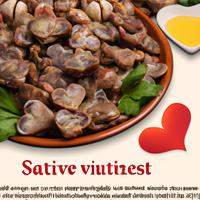
1 serving (100 grams) contains 153 calories, 27.0 grams of protein, 3.6 grams of fat, and 0.0 grams of carbohydrates.

Log this food in SnapCalorie

Nutrition Information
Calories |
364.3 | ||
|---|---|---|---|
% Daily Value* |
|||
| Total Fat | 8.6 g | 11% | |
| Saturated Fat | 2.4 g | 12% | |
| Polyunsaturated Fat | 0 g | ||
| Cholesterol | 881.0 mg | 293% | |
| Sodium | 161.9 mg | 7% | |
| Total Carbohydrates | 0 g | 0% | |
| Dietary Fiber | 0 g | 0% | |
| Sugars | 0 g | ||
| protein | 64.3 g | 128% | |
| Vitamin D | 0 mcg | 0% | |
| Calcium | 26.2 mg | 2% | |
| Iron | 6.0 mg | 33% | |
| Potassium | 571.4 mg | 12% | |
* Percent Daily Values are based on a 2,000 calorie diet. Your daily values may be higher or lower depending on your calorie needs.
Food Attributes
Source of Calories
About Chicken gizzards and hearts
Chicken gizzards and hearts are nutrient-dense organ meats typically featured in various cuisines, including Southern American, Asian, and African dishes. Gizzards, part of the chicken's digestive system, and hearts, the muscle that pumps blood, are rich in protein and essential vitamins like vitamin B12, riboflavin, and iron, which promote red blood cell production and energy metabolism. They provide minerals like zinc and phosphorus, supporting immune health and bone strength. While low in carbohydrates, they are high in cholesterol, making moderation key for those monitoring heart health. Often prepared fried, grilled, or stewed, these cuts are a flavorful addition to hearty meals. Their chewy texture and bold taste make them a staple in traditional comfort foods worldwide, showcasing their cultural importance and versatility in cooking. For a healthier option, they can be steamed or sautéed to retain nutrients while minimizing added fats.



